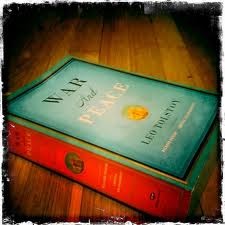Welcome back from our mid-summer break, War & Peace read-alongers.
If you're new to our featured read-along, here's what you need to know: We took on the ultimate Tolstoy chunkster in July and are now officially past the half-way mark.
By the end of August, we'll be able to say that we are among the few, the proud, the War & Peace-ers.
Here's the upcoming schedule (also accessible on the Read-Alongs tab above):
8/17: Book Three, Part 3 and Book Four, Parts 1 & 2
8/22: Book Four, Parts 3 & 4
8/29: Epilogue & Whole Book Discussion
Today's post features Volume Three, Books One and Two. No spoilers this time, but rather some general reflections on the merits of this particular chunkster....
So, at this point one feels as though the major characters are simply a part of one's own life, and one actually looks forward to experiencing their shifting perspectives and personal development. I'd say that's one of Tolstoy's strengths in War and Peace, as opposed to Anna Karenina: All of the major characters are dynamic as they keep shifting, learning, and changing quite realistically over the course of the novel, so even if they're not entirely sympathetic, they're entirely 'real' to us. What an achievement, when you think of it: These characters - Prince Andrei, Nicolai Rostov, Pierre, and even (drat it!) Natasha Rostov - shift not only their psychological stances but also their deeper philosophies as a result of their life experiences and - with all this novel's length - we trace their personal evolution beside them.
This aspect of War and Peace is truly quite enthralling and, having wished I'd never spent all those hours slogging through Anna Karenina, I did not expect it from Tolstoy. As you can imagine, knowing that the enormous investment of time will be immediately rewarding page by page makes facing the sheer heft of this small-print, 1200+ page tome more than bearable. And I already anticipate my own typical action when faced with the waning pages of a novel that creates a world - as War and Peace indubitably does - and offers characters who feel like friends, neighbors, colleagues: I'll be slowing down my pace to make the end of this one last.
This time around, I'm not going to offer a plot summary, just a brief synopsis focused on theme:
More Napoleonic wars ensue, and the focus in these volumes offers us nuanced scenes of the politics among heads of state, local aristocrats and businesspeople, plus reflections on war as a recurring, seemingly inevitable aspect of human social behavior. The war focus is balanced, of course, by the static - or predictably recurring - nature of life among the peace-ers: those left behind at home.
Military service as a refuge from one's personal responsibilities back at home is a recurring theme as well, making us question our assumption that those who enlist do so as patriots or courageous idealists or self-sacrificing heroes for the community, and offering an alternative motive, especially for those characters who come from privilege and can thus pick their positions within the military: It's a way to escape the decision-making of their peacetime lives and perhaps earn glory among men along the way.
Here's to an increasingly rich and enjoyable journey into past, fictional lives, yet with thought-provoking implications for our current real ones.
Shout out to Laura at Booksnob blog, who's also posting about her War & Peace reading experiences.
MFB,
L

2 comments:
Thanks for the shout out. Still very far behind you. Once I finish Roots, I should be able to pick up the pace on War and Peace, I hope.
I first tried to read War and Peace in High School. A teacher, who had carried the book all through the Pacific campaign in WWII recommended it as a book that had changed his life. I tried three times and couldn't get past a few hundred pages because of the numerous characters - each with multiple names. The fourth time I stuck with it and was rewarded with a reading experience that has seldom been equaled. Since that time I have reread the book every two or three years, so I must have been through it 15 or more times, and each time I find things I haven't noticed before.
Post a Comment